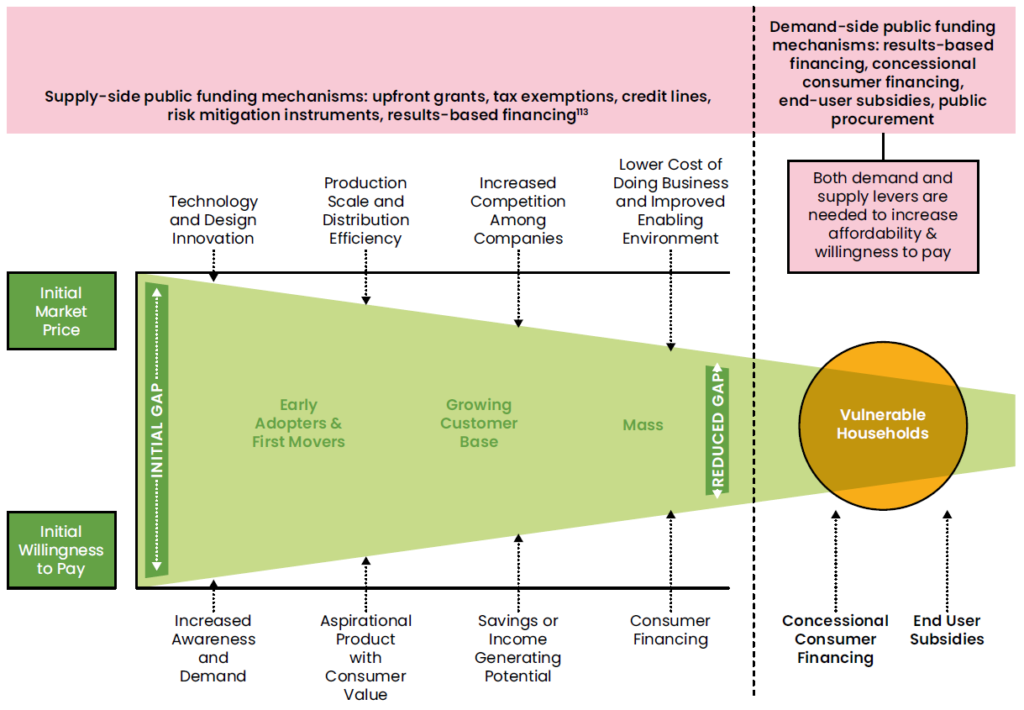By Jem Porcaro, Jakub Vrba, Charlie Miller, and Stephen Kent*
The world is not on track to achieve Sustainable Development Goal 7 (SDG7). On current trends 670 million people will remain without access to electricity in 2030, with 565 million of them in Sub-Saharan Africa, while a quarter of the world’s people will still be without access to clean cooking solutions.
Availability and affordability are the two major barriers preventing people from gaining access to modern energy services. Millions of people live in places that are disconnected from electricity grids where off-grid solutions are not yet available to them. Millions more might be able to access electricity or clean cooking solutions, but the price of doing so is beyond their means.
Before the COVID-19 pandemic, almost half of people without access to electricity in Sub-Saharan Africa did not have the ability to pay for an essential bundle of services, and 700 million people with access in Africa and developing countries in Asia could not afford an extended bundle of services. Since COVID, affordability has become even more of a challenge: an additional 90 million connected people in Africa and developing countries in Asia were unable to afford an extended bundle of energy services in 2020.
The potential cost of making modern energy services affordable to all is immense. In addition to USD 18.8 billion in grant, debt and equity investment, the off-grid solar sector alone needs USD 4.5 billion in end-user subsidies to close the affordability gap. The mini-grid sector faces similar challenges, where in Nigeria alone, an investment of USD 681 million is required to make mini-grids affordable to consumers. It is unclear where this money will come from, but development, climate, social impact, and public finance can all play important roles.
In this context, it is vital that scarce public funds are used as efficiently as possible to address the affordability challenge. Supply-side funding mechanisms, which are designed to reduce the cost and risk of supplying products to end users, can help to minimize the need for end-user subsidies by creating demand, making consumer finance available, and unlocking economies of scale in distribution.
End-user subsidies, when rolled out at scale, can place a significant burden on public finances, and a long-term source of public funding must be found to pay for them. With supply-side funding mechanisms not being sufficient on their own to close the affordability gap and end-user subsidies draining public budgets, we need to look at other ways to address affordability. This is where concessional consumer financing could step in.

Figure 1: How supply-side and demand-side public funding mechanisms can be used to bridge the affordability gap.
Concessional consumer financing is an overlooked solution in an energy access setting despite its potential to help address affordability.
Concessional consumer financing (CCF) is financing with an interest rate that is lower than commercial rates. CCF is often made available by governments for products or services that deliver on desirable social, economic, and/or environmental outcomes. CCF could potentially be used to target a wide range of products including low-tier lighting systems, household, or productive use systems, as well as solar generators.
In Europe and North America, CCF is a commonly used public funding mechanism to overcome high upfront costs and enable households to access renewable energy and energy efficiency products such as heat pumps, electric vehicles, and home insulation. The Scottish Government, for example, has supported zero-interest loans for more than a decade to meet its national emission reduction targets. But despite the high uptake and impressive repayment rates, CCF has rarely been used in an energy access setting in Sub-Saharan Africa.
One notable example of CCF in an energy access setting comes from the IDCOL solar home system (SHS) programme in Bangladesh, which enabled one-quarter of previously unelectrified households– around 20 million people – to gain access to electricity. Although the high population density and the mature market of microfinance institutions (MFIs) are not directly comparable to many countries in Sub-Saharan Africa, CCF has the potential to reduce the affordability gap and cancel the “poverty premium” faced by poorer customers who are unable to pay for products over the counter in cash.
CCF models relevant in an energy access setting can be split into two categories: third-party lending and direct lending by energy service providers. Third-party lenders could include development banks; commercial banks, MFIs or Savings and Credit Cooperatives (SACCOs); or non-profit organizations. Energy service providers that could lend directly include utilities; mini-grid developers; and pay-as-you-go (PAYG) companies.
Analysis by Energy Saving Trust suggests that CCF could help to make lower Tier electricity access products affordable, support households with moving up the energy ladder more quickly, and enable access to larger SHS or productive use systems. For example, zero-interest loans extended over a 5-year repayment period could nearly close the affordability gap in Sub-Saharan Africa if PAYG was available to everyone. Even in countries with low electrification rates and low ability to pay like Malawi, CCF could significantly move the needle by increasing affordability for a multi-light and mobile charger from 16 percent with the traditional PAYG model to more than 80 percent of households with CCF over five years.

Figure 2. Impact of concessional consumer financing on affordability of pay-as-you-go solar systems across Sub-Saharan Africa (methodology and datasets derived from the Off-Grid Solar Market Trends Report 2022 [10])
There is a need to test CCF approaches in energy access settings before they can be rolled out at scale. The most significant impact of CCF on affordability would be achieved with extended repayment periods, but consumer behaviour, as well as company costs and risks, are all highly uncertain in this model. CCF would also need to be compared with end-user price subsidies to evaluate its effectiveness when it comes to the use of public resources. We need to pilot the CCF model to answer these questions. If successful, CCF could provide governments and other public funding providers with an attractive, cost-efficient, and sustainable solution to the affordability challenge and move us closer towards achieving SDG7.
Source: SEforAll
Co-Authors:
Jem Porcaro, Head of Energy Access, Sustainable Energy for All
Jakub Vrba, Senior Research Analyst, Energy Saving Trust
Charlie Miller, Senior Policy Consultant, Energy Saving Trust
Stephen Kent, Communications Specialist, Sustainable Energy for All









